
Keke Kaikhosroshvili
Keke is Zavvy's expert in learning experience. On our blog, she shares experience and insights based on her studies in learning design and experiences made with our customers.

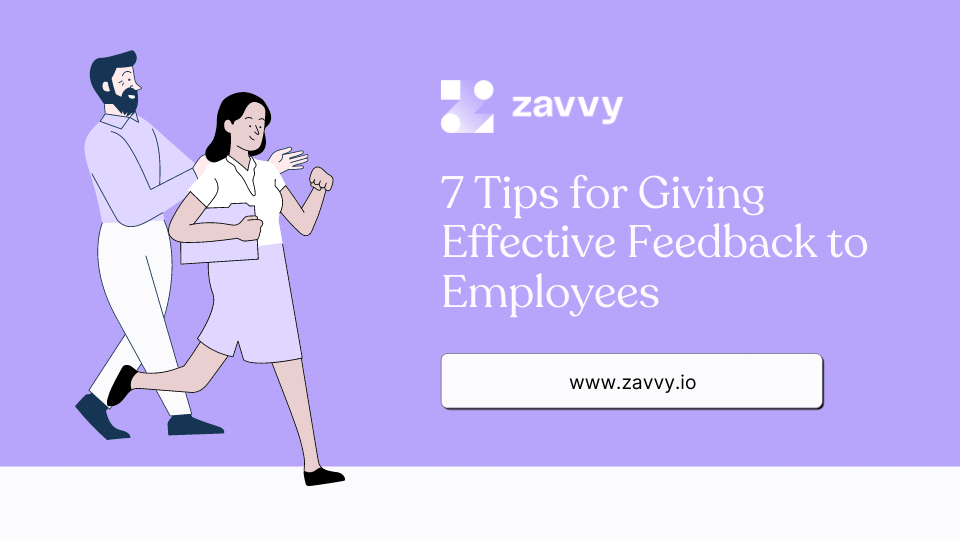
Giving effective feedback is crucial in the development and retention stage of employee experience. Your employees are no longer candidates who need to be babysat. As full-fledged members of the organization, it's time for them to know how well they're doing and how solid their stance is in shaping its future.
More importantly, your role as their manager is to give valuable feedback. But leaders/mentors often walk a tightrope in balancing constructive criticism and appraisal. You want to compliment your employees and, at the same time, correct them without going overboard.
Yet, it is easy to make mistakes while giving feedback. For example, choosing a wrong setting, piling up criticisms, and having negative body language. Providing effective feedback guarantees that your message gets across clearly, and your workers become motivated to perform better. This is where an effective employee feedback strategy comes in.
69% of employees work harder when their efforts are recognized. If the reverse is the case in your organization, then it's a sign for you to re-evaluate your performance review strategy.
Lucky for you, we've outlined seven critical tips for providing effective feedback to employees.
Together with our curators, we have created a library of actionable digital marketing resources. Personalized to your team's needs.
Effective feedback refers to giving valuable and corrective information to employees to improve their performance. Effective feedback can be positive and negative, and usually focuses on a specific behavior or situation.
For your feedback to be effective, it needs to be:
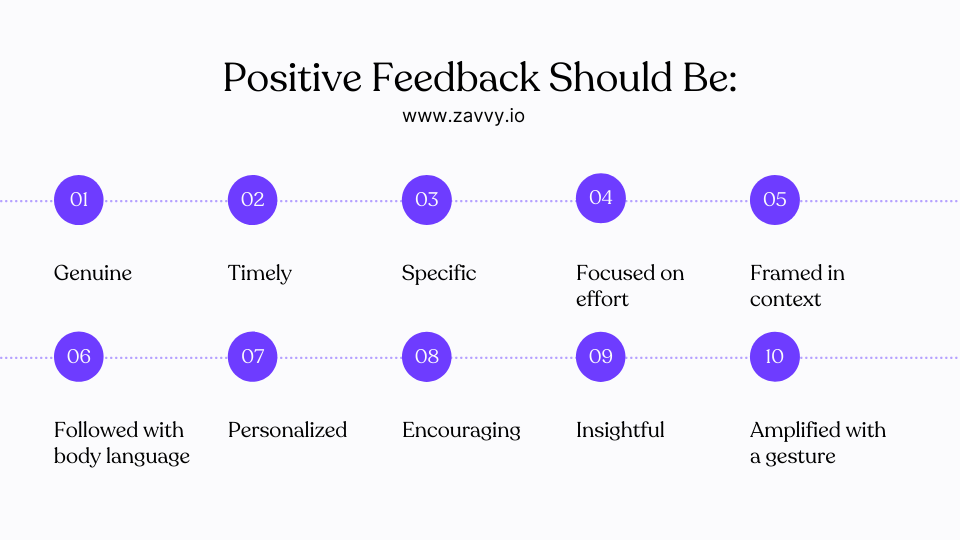
You might be tempted to pack the feedback sandwich with your lunch. A feedback sandwich is when you praise your employee, call them out on their mistakes, and then praise them again. If this is you, start doing the opposite.
This method beats around the bush and makes it hard for employees to see your main point. Instead, begin with a positive comment. This could be about your employees' latest achievements or a project they're currently working on.
Say something along the lines of, "Anna, I'm really impressed with your UI design for our fitness app. You're setting a great example for everyone on the team." Then proceed to deliver constructive feedback phrases.
Here's how you can do that without sounding intimidating:
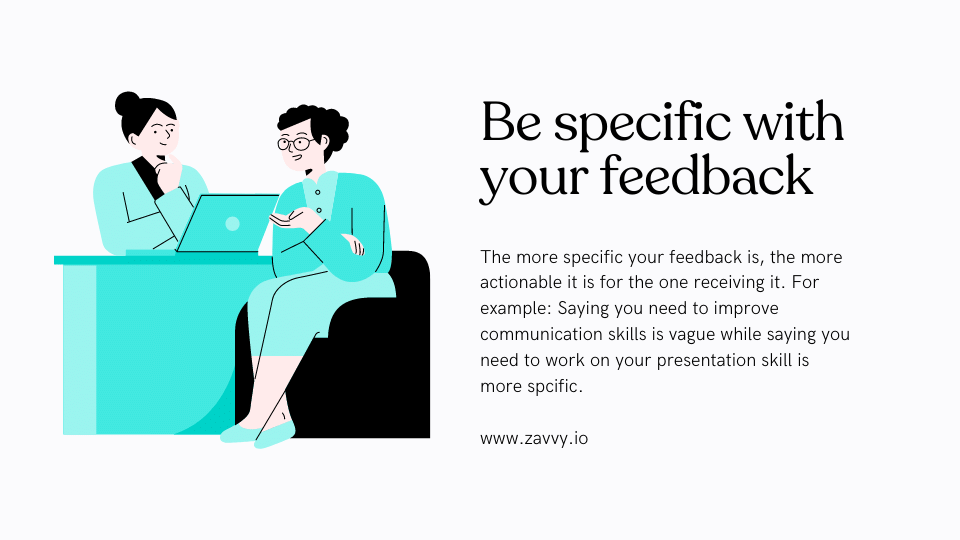
Let's take a look at these two examples:
"Anna, I love the new interactive buttons you've added to our fitness app. I just feel that they're conflicting with the theme. Can you reduce the sizes?"
Versus…
"Anna, great job! But you need to improve your designs."
The first statement is specific feedback. It tells the employee their strengths and where they need to make changes in their work. Meanwhile, the second statement is generic and confusing. It doesn't show the UX designer what it is about the designs that they need to modify.
In giving specific employee feedback like the first statement, Michael Alexis, CEO at teambuilding.com, says:
My number one tip for giving employee feedback is to be more direct. Try asking your team members, "on a scale of 1 to 10, how direct are you with feedback?". Many people will answer "6 or 7 or 8", explaining that it helps cushion the message and protect the recipient's feelings.
Then, ask a follow-up question of, "on that same scale, how directly do you want to receive feedback?". You will hear a lot of 9s and 10s. The point is that people want direct feedback and are more resilient than you may think. When you give people clear and transparent information, you also give them the opportunity to respond, explain, improve, and so on - it's a win-win."
Objectivity in giving feedback means referring to behaviors that you observed yourself. Don't base your feedback on rumors and hearsays circulating the workspace. Instead, turn your observation into data points to make your feedback solid and impactful.
For example, don't use phrases like, "You're always late to work, and it's beginning to affect your performance." This statement creates room for defensiveness with employees who are likely to counter your opinion instead of adjusting their behavior.
Instead, go with the Situation-Behavior-Impact Model. For example, say, "For the past three days (the situation), you've been absent from meetings (the behavior), and I've noticed how it's affecting the progress of our current project (the impact)."
Leading the conversation down this road shows that you're aware of the problem. You've seen how it affects everyone, and now you're taking proactive steps to solve it, regardless of your personal feelings towards the employee.
Leanne Renninger, Founder of LifeLabs Learning, says that another reason for going with this approach is that it reinforces positive behavior:
We want to be able to specify exactly what we want the other person to increase or diminish. And if we stick with blur words, they actually won't have any clue particularly on what to do going forward to keep repeating that behavior.
Use these actionable feedback tips to maintain objectivity:
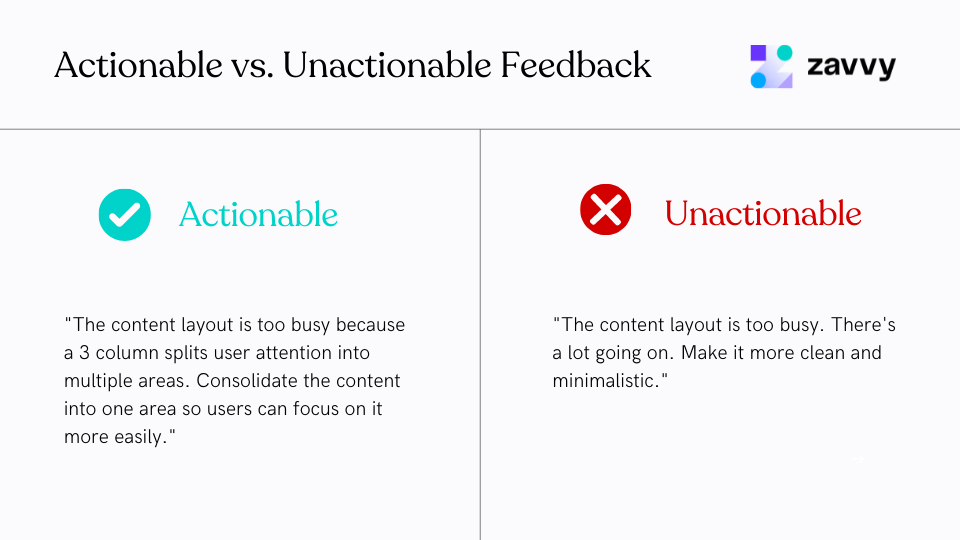
In contrast with the feedback sandwich, effective employee feedback starts positively, places constructive criticism in the middle, and ends with actionable steps that will give employees the opportunity for improvement.
It's vital that you provide these steps after relaying the bottom line of your feedback. This will help your employees feel confident afterward as it shows your concern for their progress and your care for their success. Their focus then shifts from the negative aspect of your feedback to moving forward.
For instance, you can say, "One of the habits that have helped me come early to work consistently is completing half of my to-do list the evening before. Would that also work for you?"
Other actionable steps you can take include:
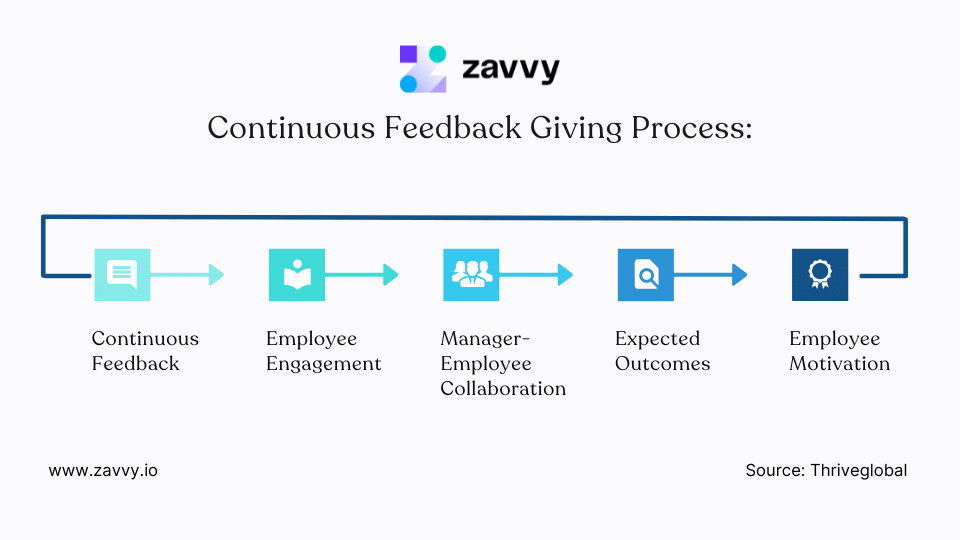
The feedback frequency depends on your organizational structure and schedule, but ideally, you should give feedback shortly after a situation occurs. The sooner you provide employees with feedback, the sooner they can make the necessary changes.
CEO of SnackNation, Sean Kelly, says that:
If you don't do that, other things will fill the space in the gap. You won't see that person or connect with them personally for another four to five days or a week or two weeks. By that time, you've lost your chance because then it's going to seem weird. If you bring it up, it's like, "What? Have you been sitting around and feeling this way?" or "have you built up any resentment?"
32% of employees have to wait more than three months to receive feedback from their team leader. In such a scenario, employees are more likely to forget certain situations or behaviors. This will make it harder for you to solve problems.
Yet, at the same time, frequent feedback can quickly become overwhelming or come off as micromanaging. Here's how to prevent that from happening:
Meeting one-on-one with employees is essential for establishing trust. It will allow them to read your body language and know if you're being transparent. It will also stimulate productivity as the employee would take the situation more seriously than reading your feedback through email.
Moreover, giving written feedback can higher the chances of misinterpretation. Your employees could easily mistake your exclamation mark as a sign of anger or yelling. In reality, you're trying to tell them the situation is urgent.
On this note, Alexandria Butler, Founder of Sista Circle, advises that:
Want to give effective employee feedback? Get to know your people. Everyone communicates differently, and everyone has different triggers. There is power in spending time with your team members to get to know them as humans.
Ask them about their favorite professional relationships and their worst professional moments. Understanding someone's personality and pet peeves will help you to provide the best feedback possible—in the best way possible.
To do that...
Note: To help people understand each others' personality, highs and lows, we developed a dedicated routine. "Conversations That Matter" is a fun bi-weekly connection routine that brings people together and encourages them to take about their "highest highs and lowest lows".
Remember that the goal of feedback is to improve employee performance, not to intimidate or corner them. The process is also about you. Having one-on-one feedback sessions with employees can shed light on unconscious managerial mistakes you're making.
Maciek Kubiak, Head of People at PhotoAiD, says that:
Listening and attentiveness are two very key tools you can count on to make your team more productive. Since constructive feedback is given in a conversation, when the other person on the team feels listened to, it cultivates trust and confidence between employees and the company.
In addition, both parties must listen to each other to dialogue and find opportunities to improve the work team's performance. Likewise, this allows a positive work environment to become a reality in organizations that encourage active listening and constructive feedback in this way.
Listening also prevents you from getting stuck trying to fix an unfixable problem. For example, the reason your employee suddenly starts showing up late might be due to family responsibilities. They may have infants or dependents who need care before leaving the house.
When you can identify the source of the situation, you can provide realistic solutions like opening a daycare unit for parents or updating their leave policies.
Become a better listener to your employees with the following steps:
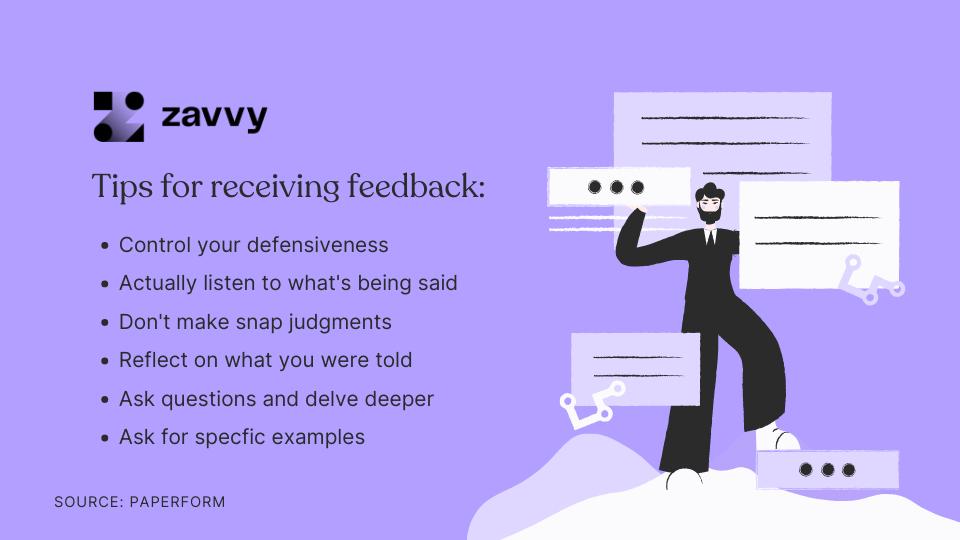
Effective feedback works both ways: for HR leaders to become better at their jobs and employees to refine their behaviors and performances.
If you find yourself at the receiving end of feedback in the workplace, the first thing you need to do is listen. Listen to the input, and don't interrupt your employees during ongoing feedback—wait until they're done talking.
But it's not just about being patient in listening. Be open to the speaker's suggestions and ideas. When you've heard it all, mind your responses. Actions speak louder than words, so the slightest raise in your tone or change in your body language can send a negative message.
Ask questions and for examples of instances where you've made mistakes to get clarification. Reflect on what you've just heard, and don't be quick to make excuses. Instead, think of the validity of the feedback. The speaker is only a fraction of the total headcount in the organization, so you don't always have to act on it.
Double-check with other employees to see how accurate the feedback is before making decisions. Here are some additional steps you can take to receive feedback professionally in the workplace:
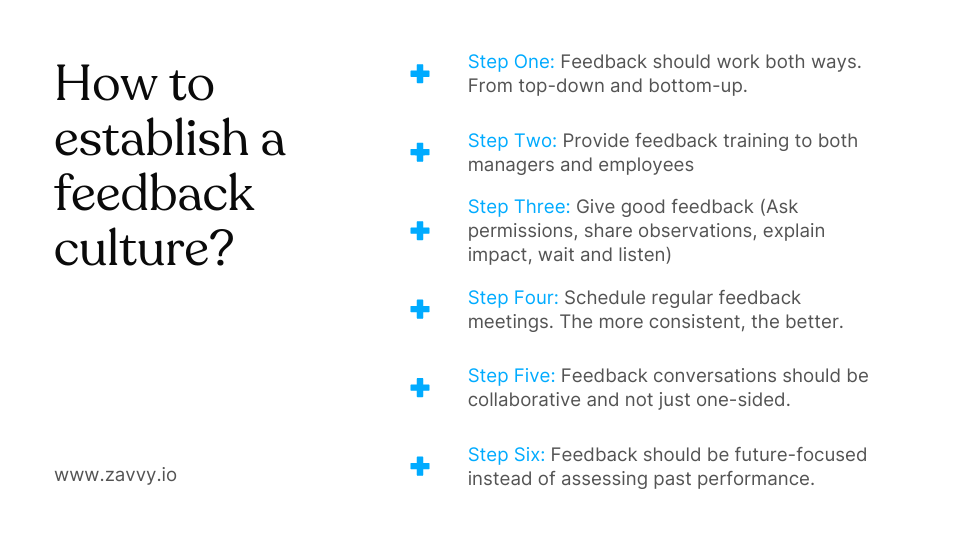
A feedback culture refers to the habit of sharing peer-to-peer feedback within an organization. A good feedback culture is one where employees feel they can share their thoughts, regardless of the role of the receiver. Employees are more likely to fall in line with feedback if they see that their leaders practice what they preach and that no one is above the system.
The following best practices will help you implement a healthy feedback culture in your organization:
Every staff in the organization should learn how to receive and give feedback, from the lowest rank to the top of the hierarchy. It helps if you construct a guideline to streamline the feedback process. Your feedback guideline should define:
Organize training classes to teach effective communication. Share materials or resources to promote fast learning. For example, about Johari Window model—a popular tool to illustrate and improve self-awareness and mutual understanding of teammates. Share the materials in the form of digital how-to guides and videos.
Many organizations find it challenging to establish a good feedback culture because of their span of control. Managers have too many staff under their wings, making it impossible to have 1-on-1 time with employees. So they depend on group feedback.
The major disadvantage of giving group appraisals is that it doesn't allow you to zoom in on one employee. Employees won't know precisely what they're doing right or what specifically is wrong with their routine. The best strategy is to combine multiple feedback channels.
For instance, assess the situation to determine what feedback structure would work. Group feedback is ideal for when you need to align multiple employees with a particular goal or outcome. But if you need to connect with employees on a deeper level, 1-on-1 discussions are the key.
Other feedback channels you can use include:
Hold your employees accountable for their actions after receiving feedback. Create a system that measures employee progress, such as using applications to track Key Performance Indicators (KPI) or encourage employees to check in daily with feedback. This way, you combine quantifiable data with face-to-face interactions and devise tangible solutions.
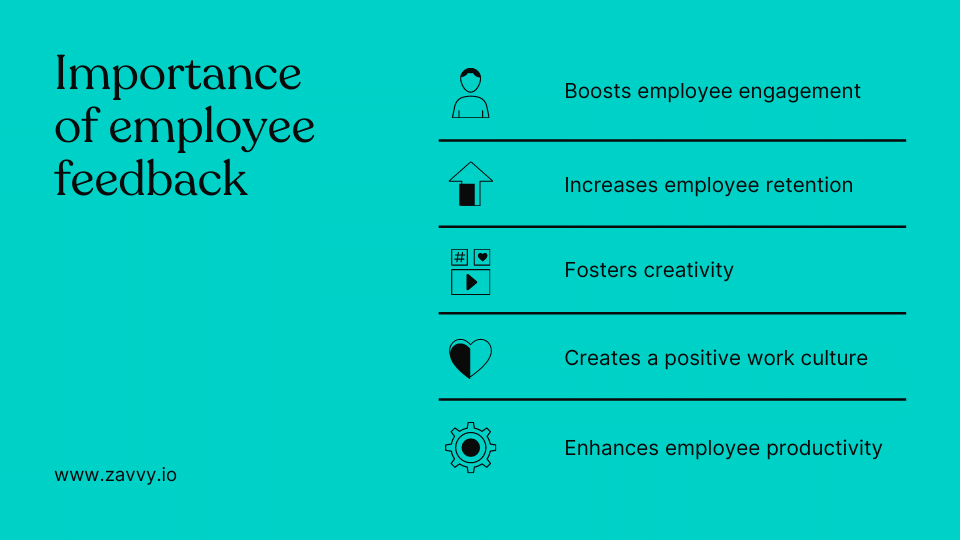
Organizations that invest in effective feedback witness a 2.5x increment in employee engagement. When you give feedback, employees experience self-awareness.
They become enlightened on the true extent of their impact on the organization and how well they're doing. If they are slacking behind, they'll be motivated to perform better.
75% of employees are caught up in monotonous tasks and prolonged hours in the workplace. This can place a strain on their wellbeing and performance, causing burnout. However, regular and effective feedback can teach them something new to upskill themselves.
Imposing your opinions and focusing on negative aspects during feedback can cause employees to develop feelings of resentment towards you. On the contrary, when you give effective feedback, it establishes a trust system where workers can tell you anything.
It also improves relationships at the candidate experience. 52% of candidates said they would reapply at an organization if they received hiring advice or feedback on their performance after rejection. This positive relationship can boost your referrals. Such candidates are most likely to leave good reviews about your organization.
Studies show a link between positive feedback and self-efficacy. Feedback can boost employee self-esteem when given effectively. It will make them think, "I'm a productive worker. I just underperformed today. However, I can be better if I follow this process". On the other hand, utterly negative feedback tells them, "you're not good enough," which can affect their mental health.
Giving feedback is hard. No one likes being the bad guy in the conversation, but you don't have to be. It gets easier when you don't leave your employees to figure out mistakes on their own.
When giving effective feedback, don't just tell your staff that they are doing something wrong, but offer solutions. Also, lead the conversation with bulleted lists of what they can do to improve. Then, work together to devise solutions instead of barking orders at them. When they improve, encourage their new behavior with rewards.
Most importantly, expect resistance along the way. Establishing an effective feedback system is not a day's work. However, with consistency in the above practices and positive reinforcement, you can experience better results in your organization over time.
Upskill your team every week with the best contents and personalized recommendations.

Giving effective feedback is crucial in the development and retention stage of employee experience. Your employees are no longer candidates who need to be babysat. As full-fledged members of the organization, it's time for them to know how well they're doing and how solid their stance is in shaping its future.
More importantly, your role as their manager is to give valuable feedback. But leaders/mentors often walk a tightrope in balancing constructive criticism and appraisal. You want to compliment your employees and, at the same time, correct them without going overboard.
Yet, it is easy to make mistakes while giving feedback. For example, choosing a wrong setting, piling up criticisms, and having negative body language. Providing effective feedback guarantees that your message gets across clearly, and your workers become motivated to perform better. This is where an effective employee feedback strategy comes in.
69% of employees work harder when their efforts are recognized. If the reverse is the case in your organization, then it's a sign for you to re-evaluate your performance review strategy.
Lucky for you, we've outlined seven critical tips for providing effective feedback to employees.
Get a demo!
We'll be happy to show you around and answer all your questions.
Trusted by innovative companies



We'll be happy to show you around, answer your questions, or arrange a free trial.
Erhalten Sie eine kostenlose Demo unserer Onboarding-Software.
Vertraut von



Your Training & Development Strategy - Solved in 1 Tool.
Trusted by innovative companies



We'll be happy to show you around, answer your questions, or arrange a free trial.
Learn how Zavvy helps you drive performance, development, and engagement.
Trusted by innovative companies



We'll be happy to show you around, answer your questions, or arrange a free trial.
We'll be happy to show you around and answer all your questions.
Trusted by innovative companies



We'll be happy to show you around, answer your questions, or arrange a free trial.
Gerne zeigen wir Ihnen ganz unverbindlich unsere Plattform im Detail.
Vertraut von modernen Unternehmen



Get a demo!
We'll be happy to show you around and answer all your questions.
Trusted by innovative companies



We'll be happy to show you around, answer your questions, or arrange a free trial.
Erhalten Sie eine kostenlose Demo unserer Software für Mitarbeiterenwicklung und Training.
Moderne Unternehmen
setzen auf Zavvy


